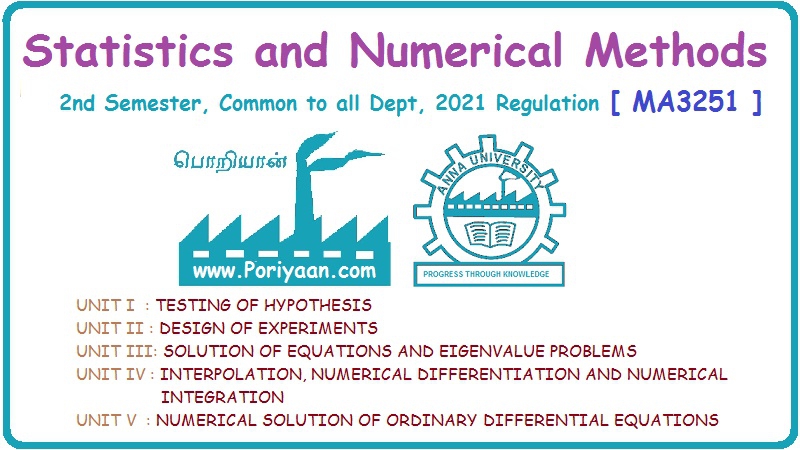Statistics and Numerical Methods: Unit II: Design of Experiments
22 factorial design
Solved Example Problems | Design of Experiments | Statistics
Factorial designs are frequently used in experiments involving several factors, where it is necessary to study the joint effect of the factors on a response.
22 FACTORIAL DESIGN :
A
major conceptual advancement in an experimental design is exemplified by
factorial design. Factorial designs are frequently used in experiments
involving several factors, where it is necessary to study the joint effect of
the factors on a response.
In
factorial designs, an assessment of each individual factor effect is based on
the whole set of measurements so that a more efficient utilisation of
experimental resources is achieved in these designs.
The
most important of these special cases is that of k factors, each at only two
levels. These levels may be quantitative, such as two values of temperature,
time or pressure or they may be qualitative, such as two machines, two
operators, the 'high' and 'low' level of a factor or perhaps the presence and
absence of a factor.
A
complete replicate of such a design requires 2 × 2 × … 2k observations
is called a 2k factorial design.
Demerits
:
Here,
each factor is measured only at two levels, it is impossible to judge, whether
the effects produced by variations in a factor are linear or perhaps, parabolic
or exponential.
22
design :
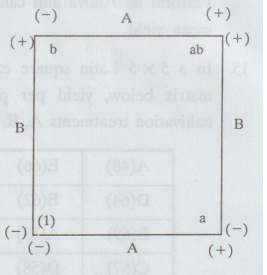
22
is the simplest design of 2k.
Two
factors A and B each at two levels that it may be low and high levels of B the
factor.
22
design can be represented geometrically as a square with the 22 = 4
runs, or treatment combinations, forming the corners of the square.
Here,
we denote low and high levels of A and B, by the signs - and +. This is
sometimes called the geometric notation for the design.
Example for 22 design :
The
simplest factorial experiment contains two levels for each two factors.
Suppose, an engineer wishes to study the total power used by each of two
different motors, A and B, running at each of two different speeds, 2000 or 3000
RPM, the factorial experiment would consist of four experimental units: motor A
at 2000 RPM, motor B at 2000 RPM, motor A at 3000 RPM, and motor B at 3000 RPM.
Each combination of a single level selected from every factor is present once.
Two-level
2-Factor Full-Factorial experiment Design pattern :
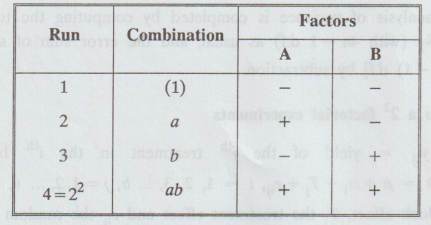
Let
the letters (1), a, b and ab also represent the totals of all n observations
taken at these design points.
To
find the main effect of A
We
would average the observations on the right side of the square in the above
figure. Where A is at the high level and subtract from this the average of the
observations on the left side of the square, where A is at the low level or
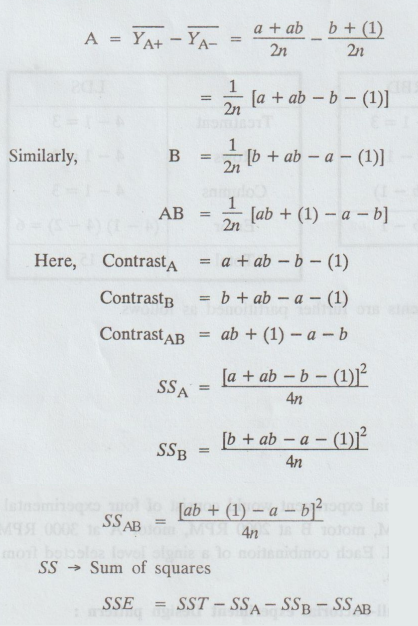
The
analysis of variance is completed by computing the total sum of squares SST
(with 4n-1 d.f) as usual, and the error sum of squares SSE (with 4 (n - 1) d.f]
by subtraction.
Analysis
fo a 22 factorial experiments
(i)
Let, yij = yield of the jth treatment in the ith
block in a R.B.D = μ + a; + Tj + eij, i = 1, 2, 3, ... b,
j = 1, 2, ... v, where ɑi is
the block effect, T; the treatment effect and eij the random error.
(ii)
The experiment is carried out on a LSD,
yijk
= μ + ßi; + ɤj + Tk + eijk, i, j, kth = treatment
in the ith row and jth column.
For
a 22 - experiment, we have 4 treatments and each block in a RBD is a
complete replicate, for a LSD (it is a 4 × 4 LSD) each row, each column is
complete replicate.
d.f.
is as follows
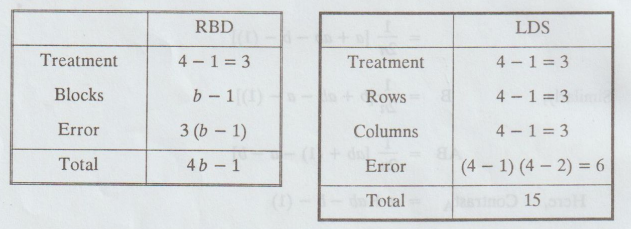
The
3 d.f due to treatments are further partitioned as follows
due
to
A
: 1
AB
: 1
Example
2.5.1
Factorial
Designs [A.U N/D 2015 R-13]
Find
out the main effects and interactions in the following 22-factorial experiment
and write down the Analysis of Variance table :

Solution:
Taking deviation from y = 37, weget

Example
2.5.2
From
the 22 factorial design of table: [A.U N/D 2011]
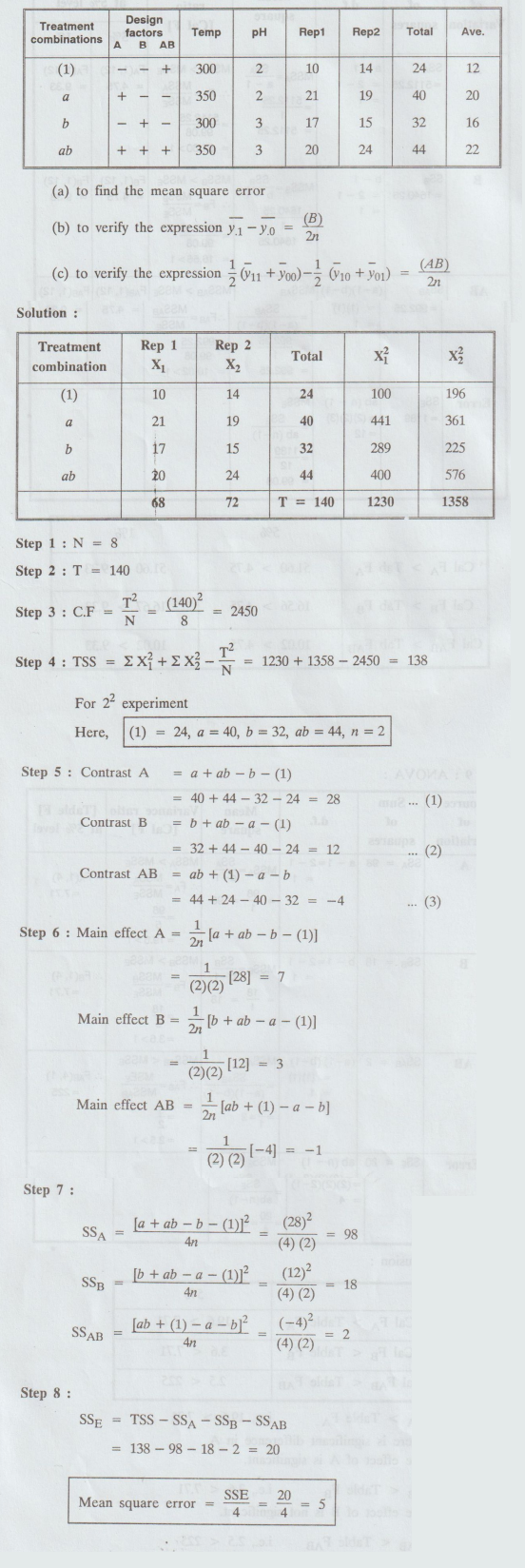

Example
2.5.3
An
experiment was planned to study the effect of sulphate of potash and super
phosphate on the yield of potatoes. All the combinations of 2 levels of super
phosphate [0 cent (b0) and 5 cent (b) /acre] and two levels of
sulphate of potash [0 cent (a0) and 5 cent (a1)/acre]
were studied in a randomised block design with 4 replications for each. The
(1/70) yields [lb. per plot = (1/70) acre obtained are given in Table : Analyse
the data and give your conclusions.
[A.U
A/M 2010] [A.U N/D 2021 (R-17)]

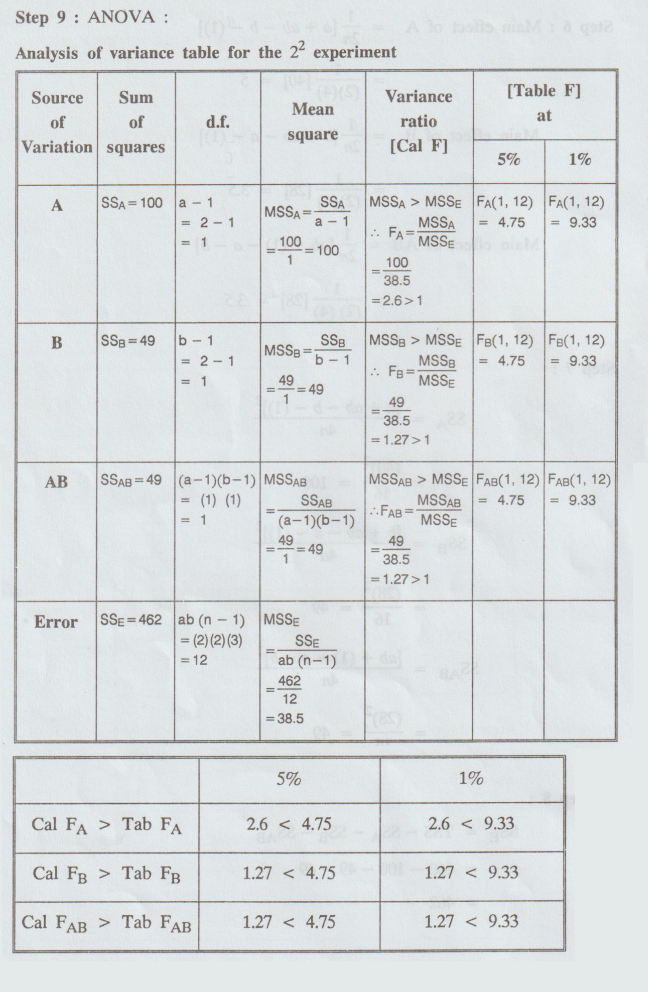
As
in each of the cases, the computed value of F is less than the corresponding
tabulated (critical) value, there are no significant main or interaction
effects present in the experiment.
Statistics and Numerical Methods: Unit II: Design of Experiments : Tag: : Solved Example Problems | Design of Experiments | Statistics - 22 factorial design
Related Topics
Related Subjects
Statistics and Numerical Methods
MA3251 2nd Semester 2021 Regulation M2 Engineering Mathematics 2 | 2nd Semester Common to all Dept 2021 Regulation
